Coursework Report: Managing Knowledge and Information Systems Analysis
VerifiedAdded on 2023/01/09
|9
|2386
|94
Report
AI Summary
This report examines the strategic importance of knowledge management in achieving long-term business objectives, using Decathlon as a case study. It explores the benefits and challenges of Radio-Frequency Identification (RFID) technology, including its impact on business processes like supply chain management, real-time data, and decision-making. The report also details key security threats to information systems, both internal (employee theft, malicious content) and external (phishing, DDoS attacks), and proposes mitigation strategies for managers. The analysis covers topics such as preventing employee hoarding, avoiding work duplication, and the implementation of biometric identification systems and employee training programs to enhance security. The conclusion summarizes the significance of knowledge management and information systems in modern business operations, emphasizing the critical role of RFID and robust security measures.
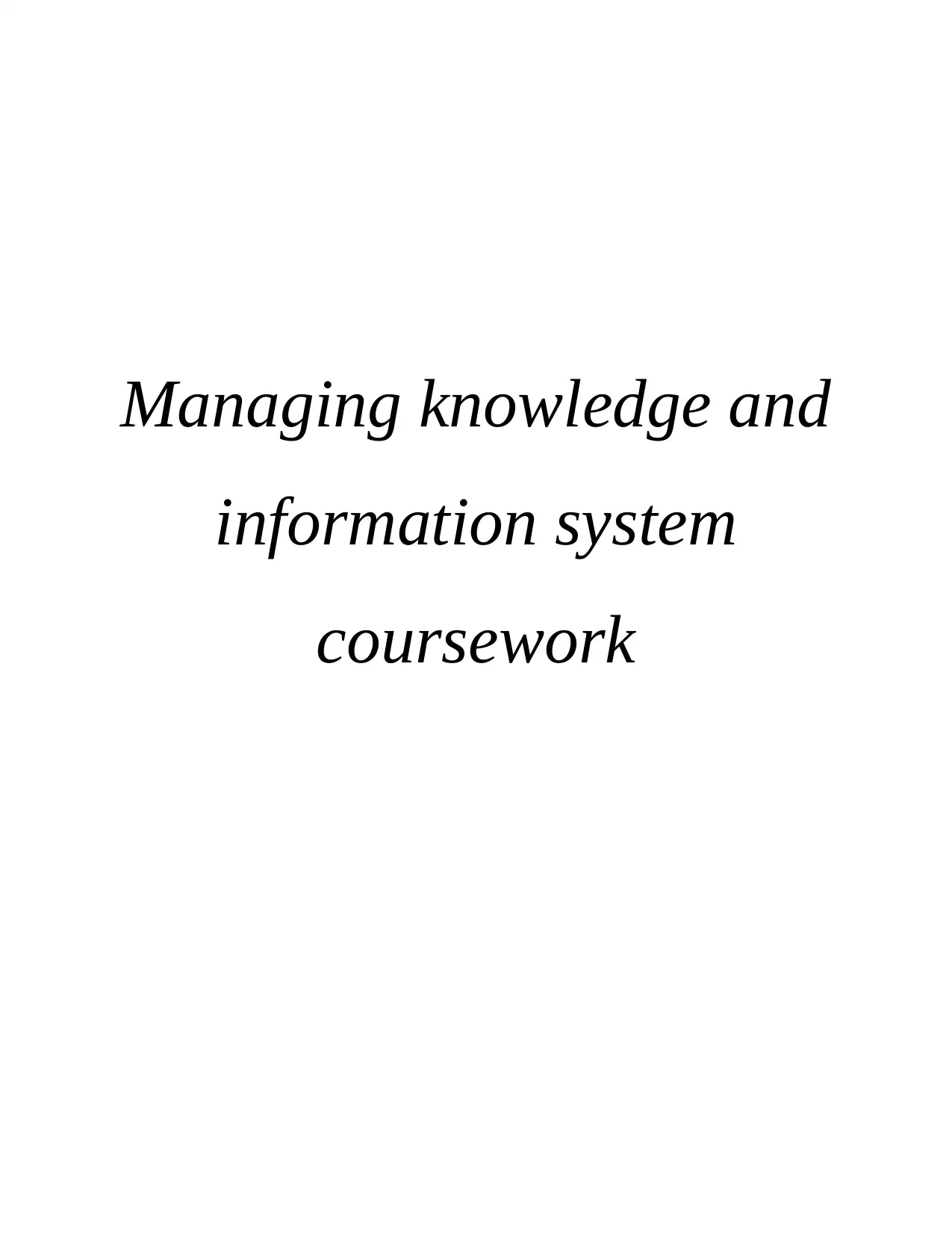
Managing knowledge and
information system
coursework
information system
coursework
Paraphrase This Document
Need a fresh take? Get an instant paraphrase of this document with our AI Paraphraser
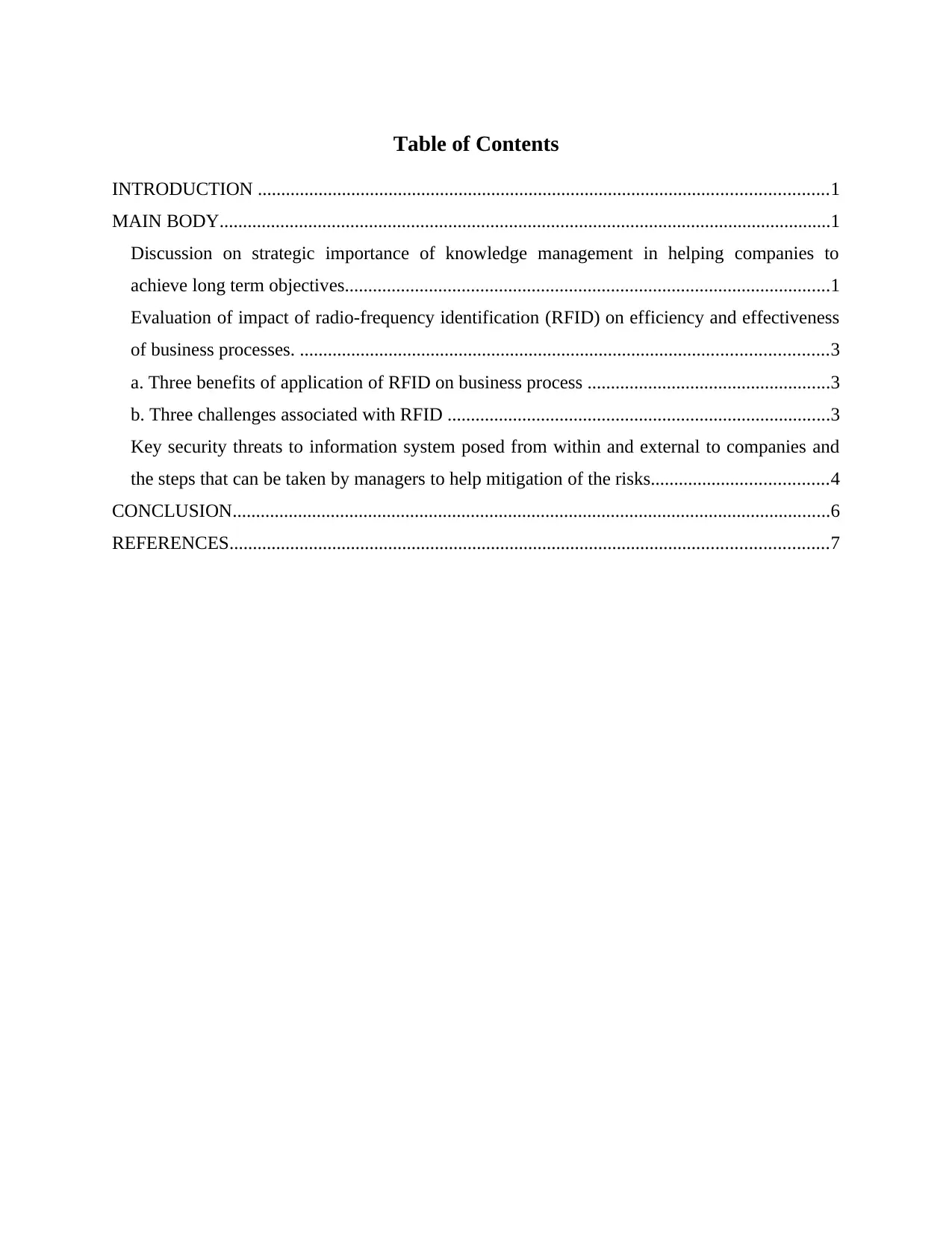
Table of Contents
INTRODUCTION ..........................................................................................................................1
MAIN BODY...................................................................................................................................1
Discussion on strategic importance of knowledge management in helping companies to
achieve long term objectives........................................................................................................1
Evaluation of impact of radio-frequency identification (RFID) on efficiency and effectiveness
of business processes. .................................................................................................................3
a. Three benefits of application of RFID on business process ....................................................3
b. Three challenges associated with RFID ..................................................................................3
Key security threats to information system posed from within and external to companies and
the steps that can be taken by managers to help mitigation of the risks......................................4
CONCLUSION................................................................................................................................6
REFERENCES................................................................................................................................7
INTRODUCTION ..........................................................................................................................1
MAIN BODY...................................................................................................................................1
Discussion on strategic importance of knowledge management in helping companies to
achieve long term objectives........................................................................................................1
Evaluation of impact of radio-frequency identification (RFID) on efficiency and effectiveness
of business processes. .................................................................................................................3
a. Three benefits of application of RFID on business process ....................................................3
b. Three challenges associated with RFID ..................................................................................3
Key security threats to information system posed from within and external to companies and
the steps that can be taken by managers to help mitigation of the risks......................................4
CONCLUSION................................................................................................................................6
REFERENCES................................................................................................................................7
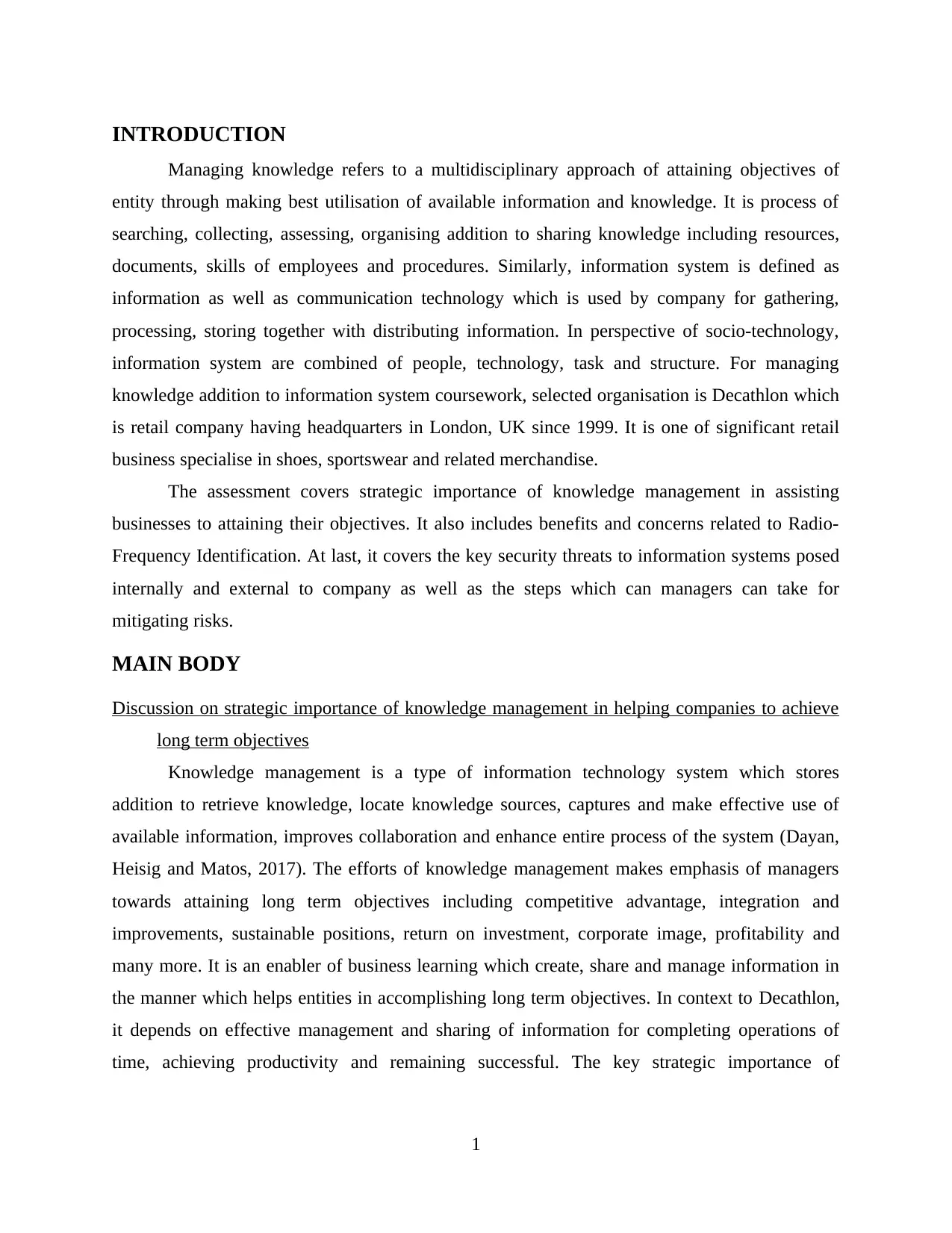
INTRODUCTION
Managing knowledge refers to a multidisciplinary approach of attaining objectives of
entity through making best utilisation of available information and knowledge. It is process of
searching, collecting, assessing, organising addition to sharing knowledge including resources,
documents, skills of employees and procedures. Similarly, information system is defined as
information as well as communication technology which is used by company for gathering,
processing, storing together with distributing information. In perspective of socio-technology,
information system are combined of people, technology, task and structure. For managing
knowledge addition to information system coursework, selected organisation is Decathlon which
is retail company having headquarters in London, UK since 1999. It is one of significant retail
business specialise in shoes, sportswear and related merchandise.
The assessment covers strategic importance of knowledge management in assisting
businesses to attaining their objectives. It also includes benefits and concerns related to Radio-
Frequency Identification. At last, it covers the key security threats to information systems posed
internally and external to company as well as the steps which can managers can take for
mitigating risks.
MAIN BODY
Discussion on strategic importance of knowledge management in helping companies to achieve
long term objectives
Knowledge management is a type of information technology system which stores
addition to retrieve knowledge, locate knowledge sources, captures and make effective use of
available information, improves collaboration and enhance entire process of the system (Dayan,
Heisig and Matos, 2017). The efforts of knowledge management makes emphasis of managers
towards attaining long term objectives including competitive advantage, integration and
improvements, sustainable positions, return on investment, corporate image, profitability and
many more. It is an enabler of business learning which create, share and manage information in
the manner which helps entities in accomplishing long term objectives. In context to Decathlon,
it depends on effective management and sharing of information for completing operations of
time, achieving productivity and remaining successful. The key strategic importance of
1
Managing knowledge refers to a multidisciplinary approach of attaining objectives of
entity through making best utilisation of available information and knowledge. It is process of
searching, collecting, assessing, organising addition to sharing knowledge including resources,
documents, skills of employees and procedures. Similarly, information system is defined as
information as well as communication technology which is used by company for gathering,
processing, storing together with distributing information. In perspective of socio-technology,
information system are combined of people, technology, task and structure. For managing
knowledge addition to information system coursework, selected organisation is Decathlon which
is retail company having headquarters in London, UK since 1999. It is one of significant retail
business specialise in shoes, sportswear and related merchandise.
The assessment covers strategic importance of knowledge management in assisting
businesses to attaining their objectives. It also includes benefits and concerns related to Radio-
Frequency Identification. At last, it covers the key security threats to information systems posed
internally and external to company as well as the steps which can managers can take for
mitigating risks.
MAIN BODY
Discussion on strategic importance of knowledge management in helping companies to achieve
long term objectives
Knowledge management is a type of information technology system which stores
addition to retrieve knowledge, locate knowledge sources, captures and make effective use of
available information, improves collaboration and enhance entire process of the system (Dayan,
Heisig and Matos, 2017). The efforts of knowledge management makes emphasis of managers
towards attaining long term objectives including competitive advantage, integration and
improvements, sustainable positions, return on investment, corporate image, profitability and
many more. It is an enabler of business learning which create, share and manage information in
the manner which helps entities in accomplishing long term objectives. In context to Decathlon,
it depends on effective management and sharing of information for completing operations of
time, achieving productivity and remaining successful. The key strategic importance of
1
⊘ This is a preview!⊘
Do you want full access?
Subscribe today to unlock all pages.

Trusted by 1+ million students worldwide
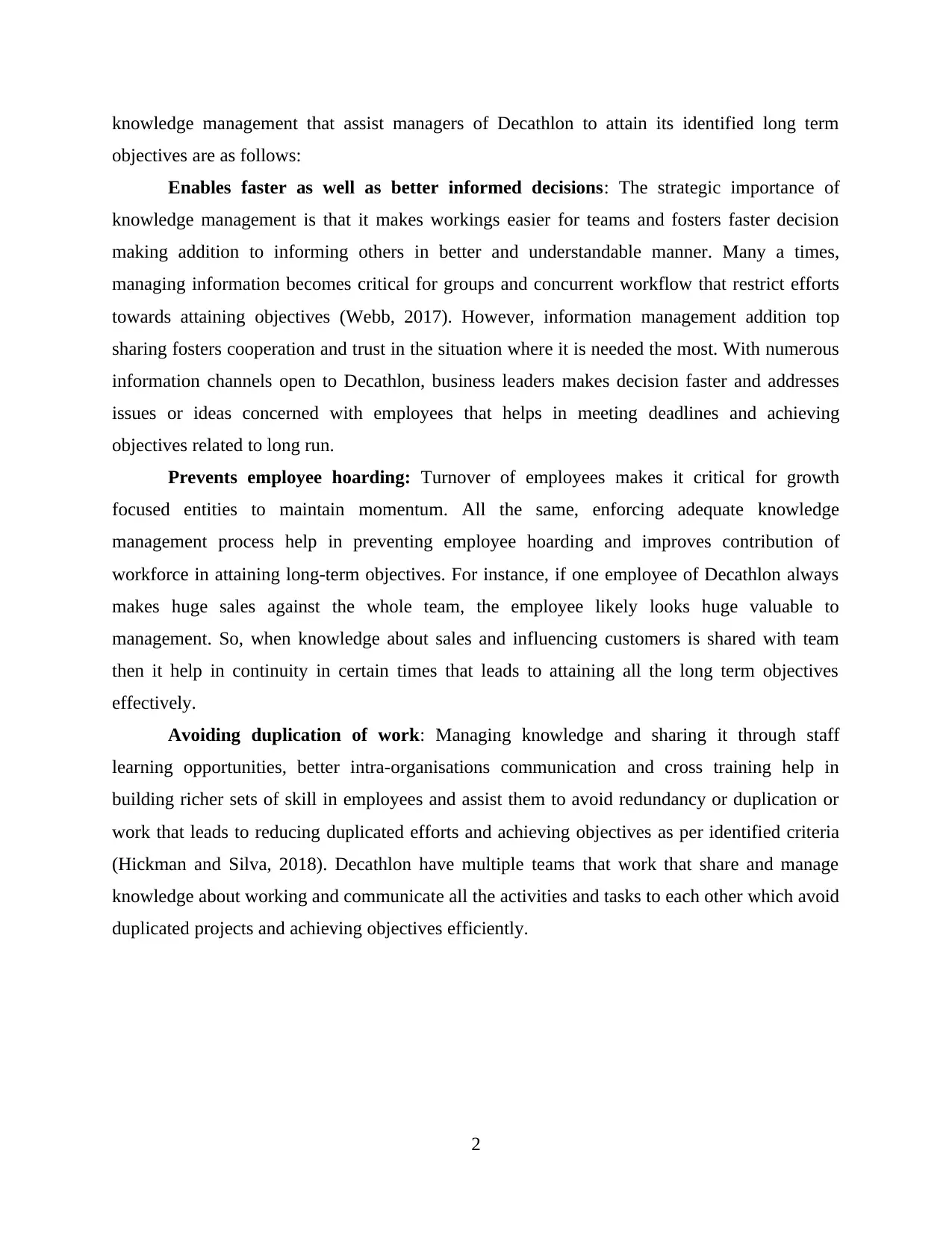
knowledge management that assist managers of Decathlon to attain its identified long term
objectives are as follows:
Enables faster as well as better informed decisions: The strategic importance of
knowledge management is that it makes workings easier for teams and fosters faster decision
making addition to informing others in better and understandable manner. Many a times,
managing information becomes critical for groups and concurrent workflow that restrict efforts
towards attaining objectives (Webb, 2017). However, information management addition top
sharing fosters cooperation and trust in the situation where it is needed the most. With numerous
information channels open to Decathlon, business leaders makes decision faster and addresses
issues or ideas concerned with employees that helps in meeting deadlines and achieving
objectives related to long run.
Prevents employee hoarding: Turnover of employees makes it critical for growth
focused entities to maintain momentum. All the same, enforcing adequate knowledge
management process help in preventing employee hoarding and improves contribution of
workforce in attaining long-term objectives. For instance, if one employee of Decathlon always
makes huge sales against the whole team, the employee likely looks huge valuable to
management. So, when knowledge about sales and influencing customers is shared with team
then it help in continuity in certain times that leads to attaining all the long term objectives
effectively.
Avoiding duplication of work: Managing knowledge and sharing it through staff
learning opportunities, better intra-organisations communication and cross training help in
building richer sets of skill in employees and assist them to avoid redundancy or duplication or
work that leads to reducing duplicated efforts and achieving objectives as per identified criteria
(Hickman and Silva, 2018). Decathlon have multiple teams that work that share and manage
knowledge about working and communicate all the activities and tasks to each other which avoid
duplicated projects and achieving objectives efficiently.
2
objectives are as follows:
Enables faster as well as better informed decisions: The strategic importance of
knowledge management is that it makes workings easier for teams and fosters faster decision
making addition to informing others in better and understandable manner. Many a times,
managing information becomes critical for groups and concurrent workflow that restrict efforts
towards attaining objectives (Webb, 2017). However, information management addition top
sharing fosters cooperation and trust in the situation where it is needed the most. With numerous
information channels open to Decathlon, business leaders makes decision faster and addresses
issues or ideas concerned with employees that helps in meeting deadlines and achieving
objectives related to long run.
Prevents employee hoarding: Turnover of employees makes it critical for growth
focused entities to maintain momentum. All the same, enforcing adequate knowledge
management process help in preventing employee hoarding and improves contribution of
workforce in attaining long-term objectives. For instance, if one employee of Decathlon always
makes huge sales against the whole team, the employee likely looks huge valuable to
management. So, when knowledge about sales and influencing customers is shared with team
then it help in continuity in certain times that leads to attaining all the long term objectives
effectively.
Avoiding duplication of work: Managing knowledge and sharing it through staff
learning opportunities, better intra-organisations communication and cross training help in
building richer sets of skill in employees and assist them to avoid redundancy or duplication or
work that leads to reducing duplicated efforts and achieving objectives as per identified criteria
(Hickman and Silva, 2018). Decathlon have multiple teams that work that share and manage
knowledge about working and communicate all the activities and tasks to each other which avoid
duplicated projects and achieving objectives efficiently.
2
Paraphrase This Document
Need a fresh take? Get an instant paraphrase of this document with our AI Paraphraser
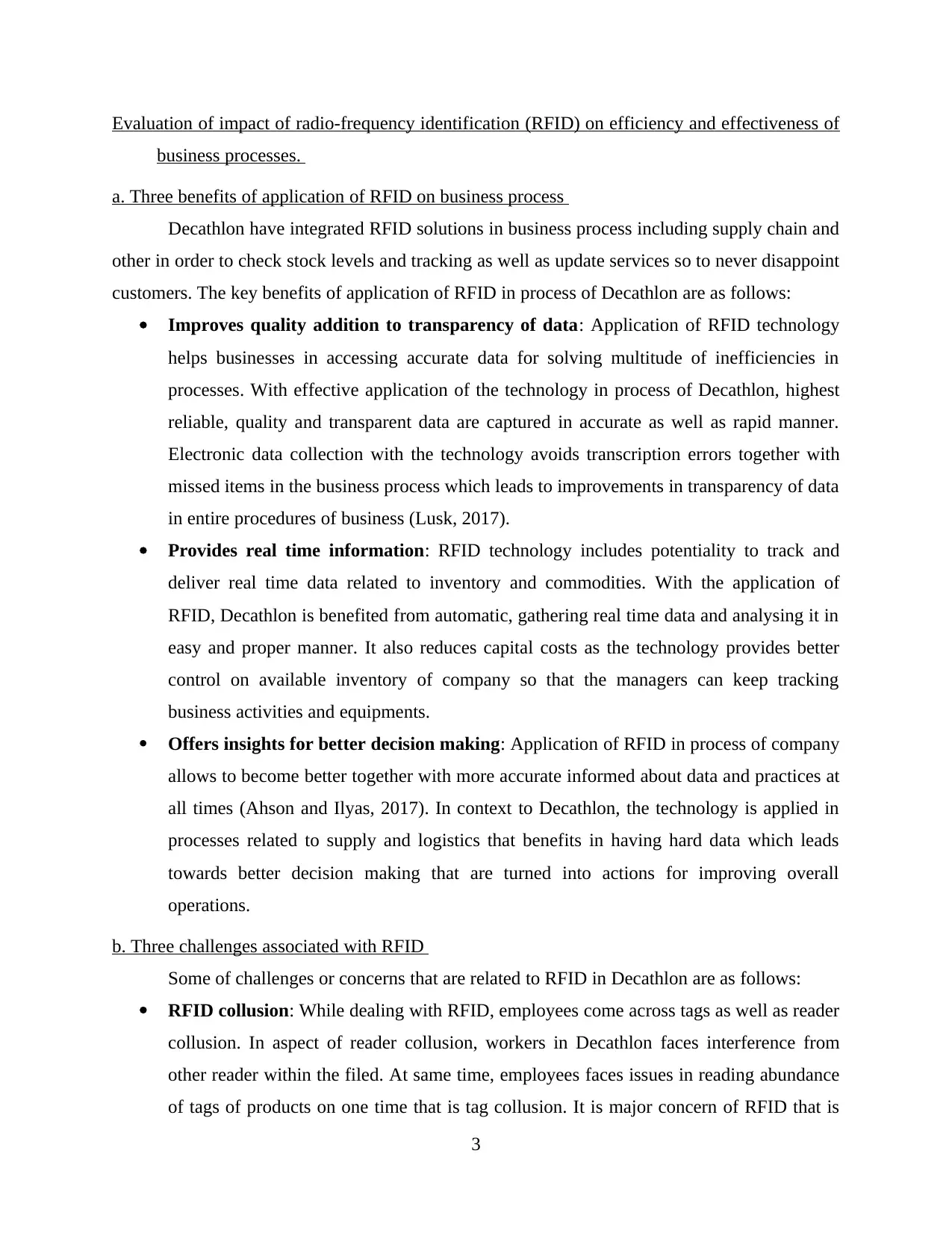
Evaluation of impact of radio-frequency identification (RFID) on efficiency and effectiveness of
business processes.
a. Three benefits of application of RFID on business process
Decathlon have integrated RFID solutions in business process including supply chain and
other in order to check stock levels and tracking as well as update services so to never disappoint
customers. The key benefits of application of RFID in process of Decathlon are as follows:
Improves quality addition to transparency of data: Application of RFID technology
helps businesses in accessing accurate data for solving multitude of inefficiencies in
processes. With effective application of the technology in process of Decathlon, highest
reliable, quality and transparent data are captured in accurate as well as rapid manner.
Electronic data collection with the technology avoids transcription errors together with
missed items in the business process which leads to improvements in transparency of data
in entire procedures of business (Lusk, 2017).
Provides real time information: RFID technology includes potentiality to track and
deliver real time data related to inventory and commodities. With the application of
RFID, Decathlon is benefited from automatic, gathering real time data and analysing it in
easy and proper manner. It also reduces capital costs as the technology provides better
control on available inventory of company so that the managers can keep tracking
business activities and equipments.
Offers insights for better decision making: Application of RFID in process of company
allows to become better together with more accurate informed about data and practices at
all times (Ahson and Ilyas, 2017). In context to Decathlon, the technology is applied in
processes related to supply and logistics that benefits in having hard data which leads
towards better decision making that are turned into actions for improving overall
operations.
b. Three challenges associated with RFID
Some of challenges or concerns that are related to RFID in Decathlon are as follows:
RFID collusion: While dealing with RFID, employees come across tags as well as reader
collusion. In aspect of reader collusion, workers in Decathlon faces interference from
other reader within the filed. At same time, employees faces issues in reading abundance
of tags of products on one time that is tag collusion. It is major concern of RFID that is
3
business processes.
a. Three benefits of application of RFID on business process
Decathlon have integrated RFID solutions in business process including supply chain and
other in order to check stock levels and tracking as well as update services so to never disappoint
customers. The key benefits of application of RFID in process of Decathlon are as follows:
Improves quality addition to transparency of data: Application of RFID technology
helps businesses in accessing accurate data for solving multitude of inefficiencies in
processes. With effective application of the technology in process of Decathlon, highest
reliable, quality and transparent data are captured in accurate as well as rapid manner.
Electronic data collection with the technology avoids transcription errors together with
missed items in the business process which leads to improvements in transparency of data
in entire procedures of business (Lusk, 2017).
Provides real time information: RFID technology includes potentiality to track and
deliver real time data related to inventory and commodities. With the application of
RFID, Decathlon is benefited from automatic, gathering real time data and analysing it in
easy and proper manner. It also reduces capital costs as the technology provides better
control on available inventory of company so that the managers can keep tracking
business activities and equipments.
Offers insights for better decision making: Application of RFID in process of company
allows to become better together with more accurate informed about data and practices at
all times (Ahson and Ilyas, 2017). In context to Decathlon, the technology is applied in
processes related to supply and logistics that benefits in having hard data which leads
towards better decision making that are turned into actions for improving overall
operations.
b. Three challenges associated with RFID
Some of challenges or concerns that are related to RFID in Decathlon are as follows:
RFID collusion: While dealing with RFID, employees come across tags as well as reader
collusion. In aspect of reader collusion, workers in Decathlon faces interference from
other reader within the filed. At same time, employees faces issues in reading abundance
of tags of products on one time that is tag collusion. It is major concern of RFID that is
3
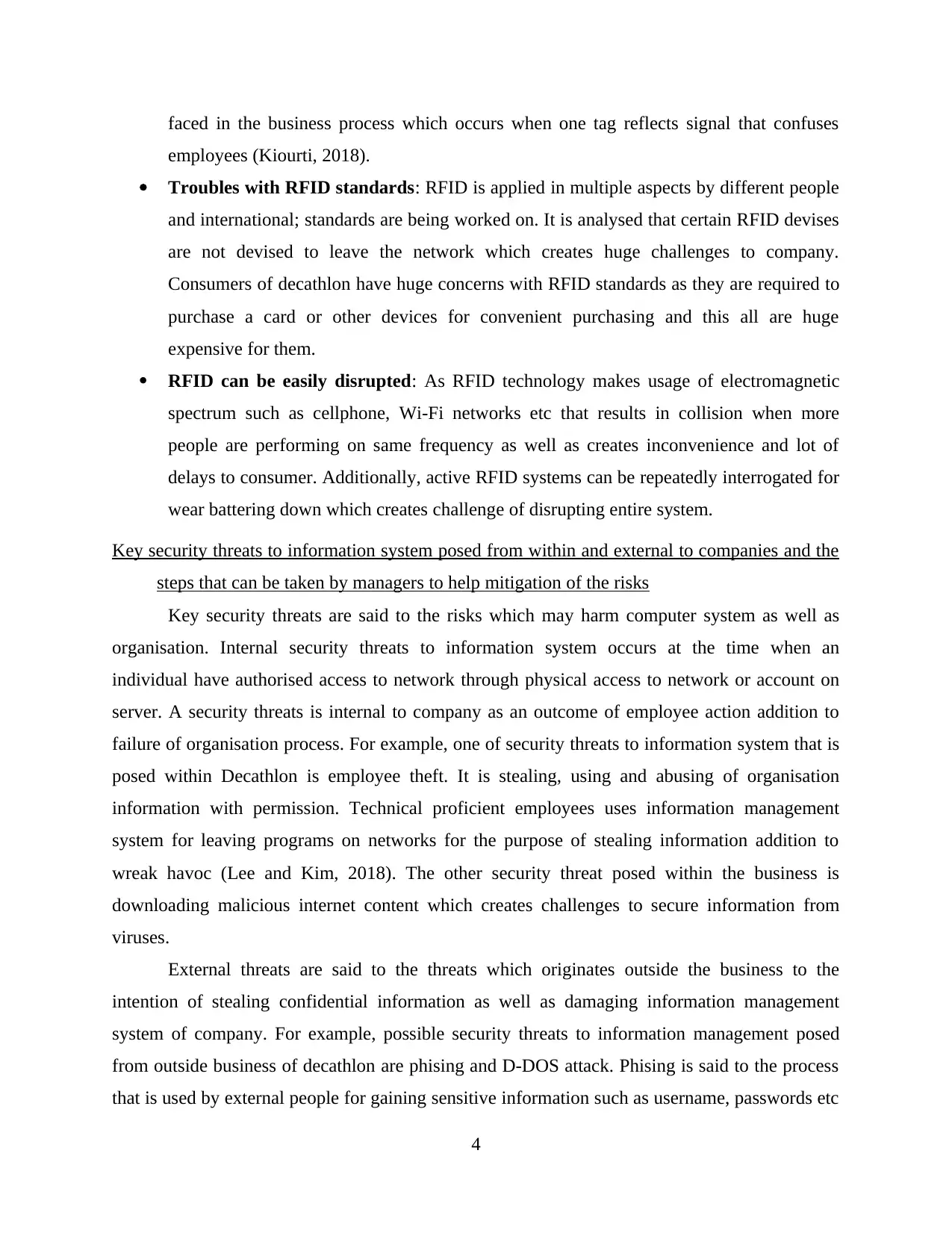
faced in the business process which occurs when one tag reflects signal that confuses
employees (Kiourti, 2018).
Troubles with RFID standards: RFID is applied in multiple aspects by different people
and international; standards are being worked on. It is analysed that certain RFID devises
are not devised to leave the network which creates huge challenges to company.
Consumers of decathlon have huge concerns with RFID standards as they are required to
purchase a card or other devices for convenient purchasing and this all are huge
expensive for them.
RFID can be easily disrupted: As RFID technology makes usage of electromagnetic
spectrum such as cellphone, Wi-Fi networks etc that results in collision when more
people are performing on same frequency as well as creates inconvenience and lot of
delays to consumer. Additionally, active RFID systems can be repeatedly interrogated for
wear battering down which creates challenge of disrupting entire system.
Key security threats to information system posed from within and external to companies and the
steps that can be taken by managers to help mitigation of the risks
Key security threats are said to the risks which may harm computer system as well as
organisation. Internal security threats to information system occurs at the time when an
individual have authorised access to network through physical access to network or account on
server. A security threats is internal to company as an outcome of employee action addition to
failure of organisation process. For example, one of security threats to information system that is
posed within Decathlon is employee theft. It is stealing, using and abusing of organisation
information with permission. Technical proficient employees uses information management
system for leaving programs on networks for the purpose of stealing information addition to
wreak havoc (Lee and Kim, 2018). The other security threat posed within the business is
downloading malicious internet content which creates challenges to secure information from
viruses.
External threats are said to the threats which originates outside the business to the
intention of stealing confidential information as well as damaging information management
system of company. For example, possible security threats to information management posed
from outside business of decathlon are phising and D-DOS attack. Phising is said to the process
that is used by external people for gaining sensitive information such as username, passwords etc
4
employees (Kiourti, 2018).
Troubles with RFID standards: RFID is applied in multiple aspects by different people
and international; standards are being worked on. It is analysed that certain RFID devises
are not devised to leave the network which creates huge challenges to company.
Consumers of decathlon have huge concerns with RFID standards as they are required to
purchase a card or other devices for convenient purchasing and this all are huge
expensive for them.
RFID can be easily disrupted: As RFID technology makes usage of electromagnetic
spectrum such as cellphone, Wi-Fi networks etc that results in collision when more
people are performing on same frequency as well as creates inconvenience and lot of
delays to consumer. Additionally, active RFID systems can be repeatedly interrogated for
wear battering down which creates challenge of disrupting entire system.
Key security threats to information system posed from within and external to companies and the
steps that can be taken by managers to help mitigation of the risks
Key security threats are said to the risks which may harm computer system as well as
organisation. Internal security threats to information system occurs at the time when an
individual have authorised access to network through physical access to network or account on
server. A security threats is internal to company as an outcome of employee action addition to
failure of organisation process. For example, one of security threats to information system that is
posed within Decathlon is employee theft. It is stealing, using and abusing of organisation
information with permission. Technical proficient employees uses information management
system for leaving programs on networks for the purpose of stealing information addition to
wreak havoc (Lee and Kim, 2018). The other security threat posed within the business is
downloading malicious internet content which creates challenges to secure information from
viruses.
External threats are said to the threats which originates outside the business to the
intention of stealing confidential information as well as damaging information management
system of company. For example, possible security threats to information management posed
from outside business of decathlon are phising and D-DOS attack. Phising is said to the process
that is used by external people for gaining sensitive information such as username, passwords etc
4
⊘ This is a preview!⊘
Do you want full access?
Subscribe today to unlock all pages.

Trusted by 1+ million students worldwide
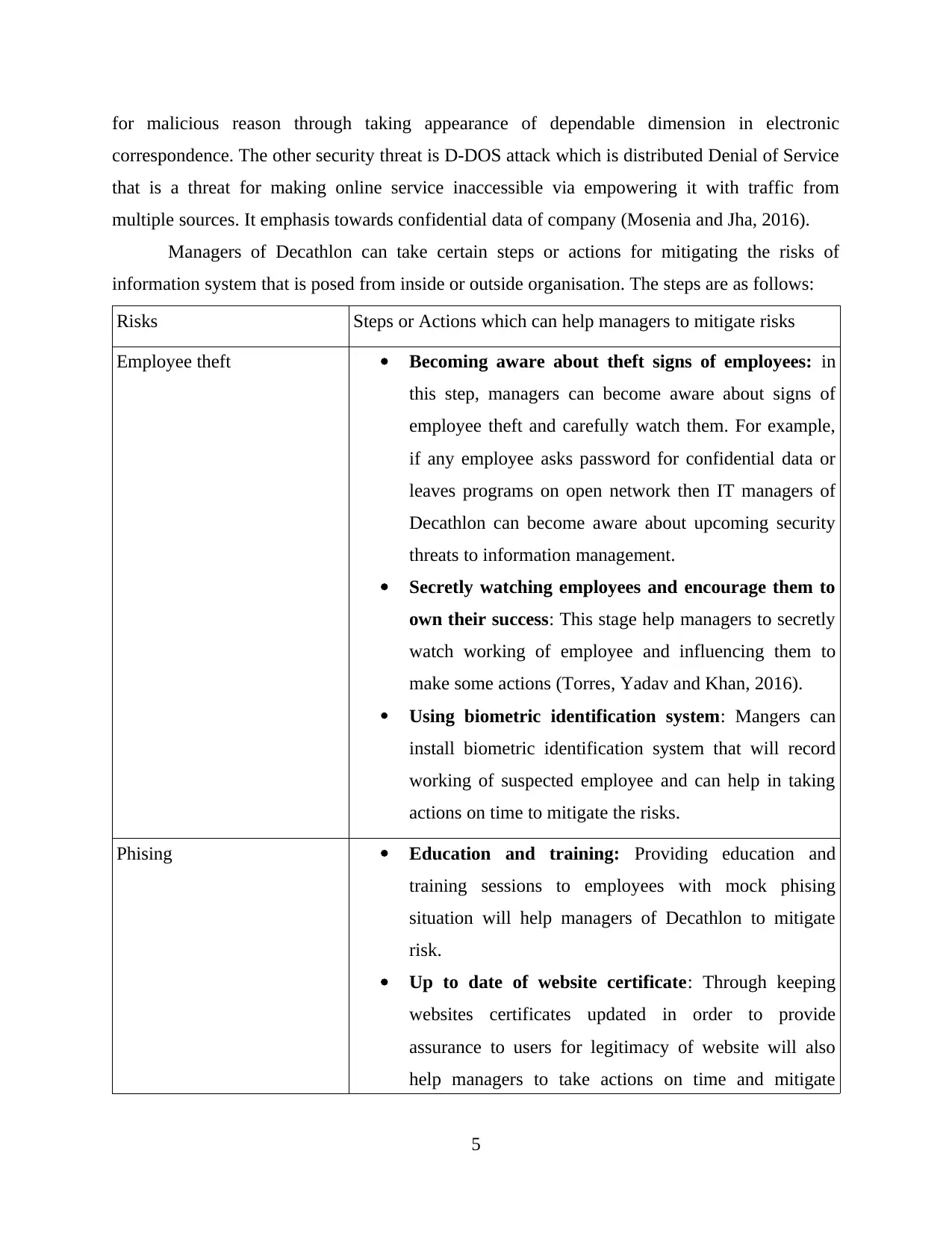
for malicious reason through taking appearance of dependable dimension in electronic
correspondence. The other security threat is D-DOS attack which is distributed Denial of Service
that is a threat for making online service inaccessible via empowering it with traffic from
multiple sources. It emphasis towards confidential data of company (Mosenia and Jha, 2016).
Managers of Decathlon can take certain steps or actions for mitigating the risks of
information system that is posed from inside or outside organisation. The steps are as follows:
Risks Steps or Actions which can help managers to mitigate risks
Employee theft Becoming aware about theft signs of employees: in
this step, managers can become aware about signs of
employee theft and carefully watch them. For example,
if any employee asks password for confidential data or
leaves programs on open network then IT managers of
Decathlon can become aware about upcoming security
threats to information management.
Secretly watching employees and encourage them to
own their success: This stage help managers to secretly
watch working of employee and influencing them to
make some actions (Torres, Yadav and Khan, 2016).
Using biometric identification system: Mangers can
install biometric identification system that will record
working of suspected employee and can help in taking
actions on time to mitigate the risks.
Phising Education and training: Providing education and
training sessions to employees with mock phising
situation will help managers of Decathlon to mitigate
risk.
Up to date of website certificate: Through keeping
websites certificates updated in order to provide
assurance to users for legitimacy of website will also
help managers to take actions on time and mitigate
5
correspondence. The other security threat is D-DOS attack which is distributed Denial of Service
that is a threat for making online service inaccessible via empowering it with traffic from
multiple sources. It emphasis towards confidential data of company (Mosenia and Jha, 2016).
Managers of Decathlon can take certain steps or actions for mitigating the risks of
information system that is posed from inside or outside organisation. The steps are as follows:
Risks Steps or Actions which can help managers to mitigate risks
Employee theft Becoming aware about theft signs of employees: in
this step, managers can become aware about signs of
employee theft and carefully watch them. For example,
if any employee asks password for confidential data or
leaves programs on open network then IT managers of
Decathlon can become aware about upcoming security
threats to information management.
Secretly watching employees and encourage them to
own their success: This stage help managers to secretly
watch working of employee and influencing them to
make some actions (Torres, Yadav and Khan, 2016).
Using biometric identification system: Mangers can
install biometric identification system that will record
working of suspected employee and can help in taking
actions on time to mitigate the risks.
Phising Education and training: Providing education and
training sessions to employees with mock phising
situation will help managers of Decathlon to mitigate
risk.
Up to date of website certificate: Through keeping
websites certificates updated in order to provide
assurance to users for legitimacy of website will also
help managers to take actions on time and mitigate
5
Paraphrase This Document
Need a fresh take? Get an instant paraphrase of this document with our AI Paraphraser
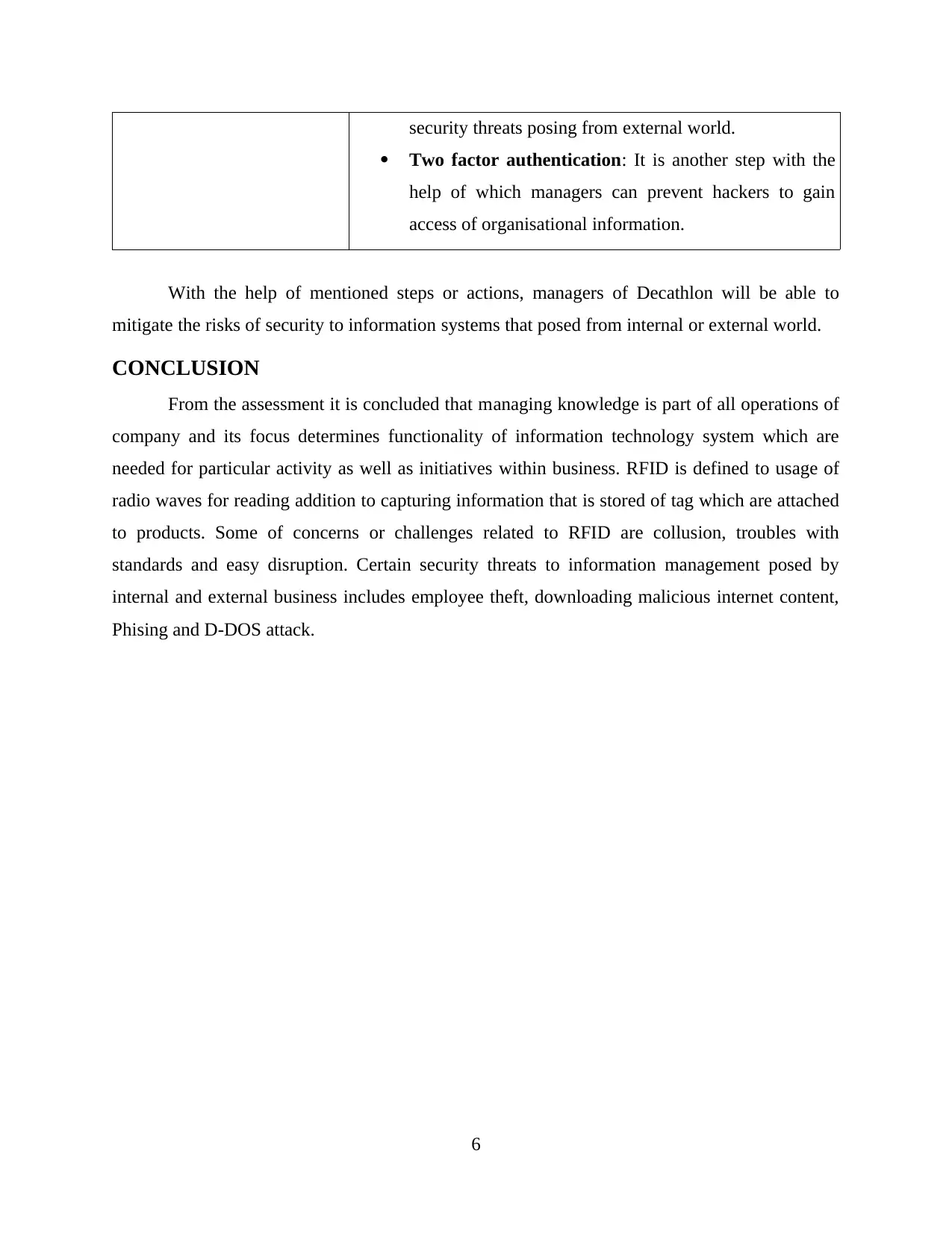
security threats posing from external world.
Two factor authentication: It is another step with the
help of which managers can prevent hackers to gain
access of organisational information.
With the help of mentioned steps or actions, managers of Decathlon will be able to
mitigate the risks of security to information systems that posed from internal or external world.
CONCLUSION
From the assessment it is concluded that managing knowledge is part of all operations of
company and its focus determines functionality of information technology system which are
needed for particular activity as well as initiatives within business. RFID is defined to usage of
radio waves for reading addition to capturing information that is stored of tag which are attached
to products. Some of concerns or challenges related to RFID are collusion, troubles with
standards and easy disruption. Certain security threats to information management posed by
internal and external business includes employee theft, downloading malicious internet content,
Phising and D-DOS attack.
6
Two factor authentication: It is another step with the
help of which managers can prevent hackers to gain
access of organisational information.
With the help of mentioned steps or actions, managers of Decathlon will be able to
mitigate the risks of security to information systems that posed from internal or external world.
CONCLUSION
From the assessment it is concluded that managing knowledge is part of all operations of
company and its focus determines functionality of information technology system which are
needed for particular activity as well as initiatives within business. RFID is defined to usage of
radio waves for reading addition to capturing information that is stored of tag which are attached
to products. Some of concerns or challenges related to RFID are collusion, troubles with
standards and easy disruption. Certain security threats to information management posed by
internal and external business includes employee theft, downloading malicious internet content,
Phising and D-DOS attack.
6
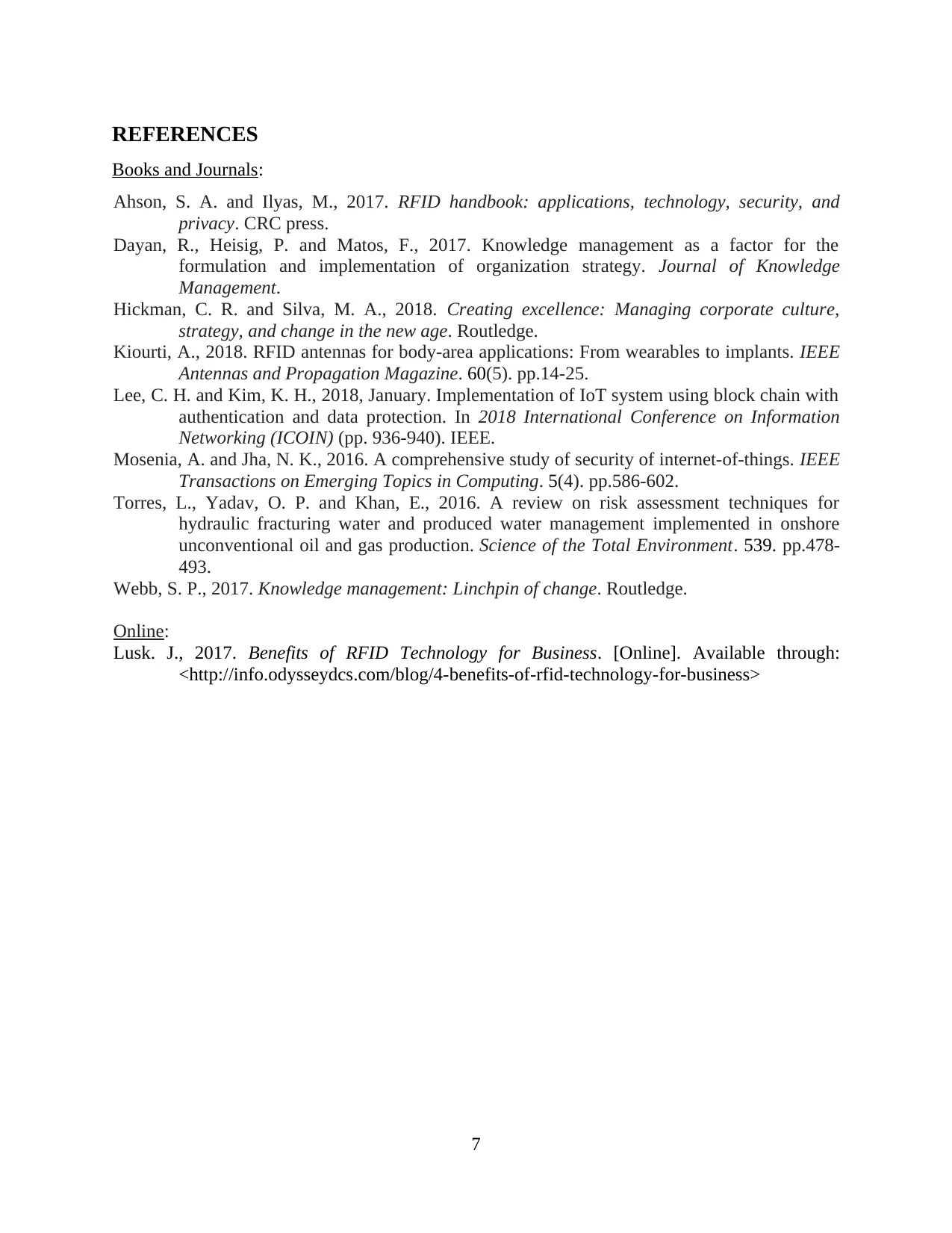
REFERENCES
Books and Journals:
Ahson, S. A. and Ilyas, M., 2017. RFID handbook: applications, technology, security, and
privacy. CRC press.
Dayan, R., Heisig, P. and Matos, F., 2017. Knowledge management as a factor for the
formulation and implementation of organization strategy. Journal of Knowledge
Management.
Hickman, C. R. and Silva, M. A., 2018. Creating excellence: Managing corporate culture,
strategy, and change in the new age. Routledge.
Kiourti, A., 2018. RFID antennas for body-area applications: From wearables to implants. IEEE
Antennas and Propagation Magazine. 60(5). pp.14-25.
Lee, C. H. and Kim, K. H., 2018, January. Implementation of IoT system using block chain with
authentication and data protection. In 2018 International Conference on Information
Networking (ICOIN) (pp. 936-940). IEEE.
Mosenia, A. and Jha, N. K., 2016. A comprehensive study of security of internet-of-things. IEEE
Transactions on Emerging Topics in Computing. 5(4). pp.586-602.
Torres, L., Yadav, O. P. and Khan, E., 2016. A review on risk assessment techniques for
hydraulic fracturing water and produced water management implemented in onshore
unconventional oil and gas production. Science of the Total Environment. 539. pp.478-
493.
Webb, S. P., 2017. Knowledge management: Linchpin of change. Routledge.
Online:
Lusk. J., 2017. Benefits of RFID Technology for Business. [Online]. Available through:
<http://info.odysseydcs.com/blog/4-benefits-of-rfid-technology-for-business>
7
Books and Journals:
Ahson, S. A. and Ilyas, M., 2017. RFID handbook: applications, technology, security, and
privacy. CRC press.
Dayan, R., Heisig, P. and Matos, F., 2017. Knowledge management as a factor for the
formulation and implementation of organization strategy. Journal of Knowledge
Management.
Hickman, C. R. and Silva, M. A., 2018. Creating excellence: Managing corporate culture,
strategy, and change in the new age. Routledge.
Kiourti, A., 2018. RFID antennas for body-area applications: From wearables to implants. IEEE
Antennas and Propagation Magazine. 60(5). pp.14-25.
Lee, C. H. and Kim, K. H., 2018, January. Implementation of IoT system using block chain with
authentication and data protection. In 2018 International Conference on Information
Networking (ICOIN) (pp. 936-940). IEEE.
Mosenia, A. and Jha, N. K., 2016. A comprehensive study of security of internet-of-things. IEEE
Transactions on Emerging Topics in Computing. 5(4). pp.586-602.
Torres, L., Yadav, O. P. and Khan, E., 2016. A review on risk assessment techniques for
hydraulic fracturing water and produced water management implemented in onshore
unconventional oil and gas production. Science of the Total Environment. 539. pp.478-
493.
Webb, S. P., 2017. Knowledge management: Linchpin of change. Routledge.
Online:
Lusk. J., 2017. Benefits of RFID Technology for Business. [Online]. Available through:
<http://info.odysseydcs.com/blog/4-benefits-of-rfid-technology-for-business>
7
⊘ This is a preview!⊘
Do you want full access?
Subscribe today to unlock all pages.

Trusted by 1+ million students worldwide
1 out of 9
Related Documents
Your All-in-One AI-Powered Toolkit for Academic Success.
+13062052269
info@desklib.com
Available 24*7 on WhatsApp / Email
![[object Object]](/_next/static/media/star-bottom.7253800d.svg)
Unlock your academic potential
Copyright © 2020–2025 A2Z Services. All Rights Reserved. Developed and managed by ZUCOL.



